How to Visit Nubian Sudan: Abri and Kerma
Ultimate Sudan Travel GuideHow to Visit Nubian Sudan: Abri and Kerma
This travel guide contains everything you need to know to visit Abri and Kerma, two of the most interesting Nubian villages in Sudan, including what to see, how to get there and where to stay. The Nubian north of Sudan is one of the most interesting parts of the country. There are ancient archeological sites from both the Pharaonic and Roman eras, dusty Nubian villages and the endless Saraha desert stretching to infinity in all directions. This travel guide contains all the most interesting attractions, how to visit them, where to stay and where to eat.
Travelling here is raw – there are no luxury hotels and practically no tourist infrastructure, although that’s not surprising really, given how few tourists visit Sudan. Of those that do, even fewer make it to this part of the country. This makes it an amazing place to visit. If the temples and historical sights of Sudan were in any other country, they’d be mobbed by tourists, but here you’ll likely have them completely to yourself.
Sudan is a poor country, thanks partly to US sanctions that were imposed in 1997, and this area is one of the poorest regions. For many people, donkeys are the primary means of transport and travelling here can feel like stepping into a bygone era. It’s interesting, but come mentally prepared – the level of poverty can be quite jarring to see.
Note on prices: The Sudanese pound is very unstable at the moment, so I’ve stated all prices in US dollars, the most commonly used foreign currency here. Apply the current exchange rate to understand approximately what you should pay.

The Meroitic tombs, such as this one in Kerma, that dot the Nubian region of Sudan are quite distinctive.
Places to Visit in Abri and Kerma
The whole northern stretch of Sudan’s Nile is peppered with interesting sights, and Abri and Kerma are two of the key villages to visit. Here, I cover some of the highlights that I visited while I was there. However, there are a large number of other ancient archeological sites and traditional Nubian villages that are also interesting if you have the time to visit them.
I list these sites from north to south, so if you’re travelling in the other direction, it would be best to visit them in reverse order.
Abri Nubian Village
The village of Abri is a dusty place on the eastern bank of the Nile. I arrived on a very windy day with sand blowing into my face, but I was still able to spend an afternoon exploring it. It’s interesting just to wander the streets and see how modern Nubians live. People are incredibly friendly – one shop keeper even gave us bottled water and absolutely refused when we tried to pay him for them, even though I insisted several times.
The other reason to visit Abri is that it’s a great base to use for exploring the nearby sights. From here, you can easily visit Sai Island, Kowikka and the temple of Soleb, plus a load of other archeological sites, over one or two days.
Directions: Abri is on the main highway on the eastern bank of the Nile. Buses run along this road from Wadi Halfa in the north and Dongola, Kerma and other villages in the south. Generally, they will drop you on the edge of the highway, from which it’s about 2 kilometres to walk to the village centre. We walked, but several locals offered us lifts. They may or may not ask for payment.

Preparing to go on an adventure in Magzoub’s ancient Morris Minor in Abri.
Sai Island
Sai island, just to the south of Abri, is the home to the ruins of an ancient Meroitic necropolis and burial ground, as well as the Nubian village of Saysab. The area of the necropolis is large and contains the ruins of many buildings. The most interesting, to me, are the conical tombs, which are a common feature of the Nubian region. If you have time, you can also check out the village of Saysab.
There is apparently a $20 per person entrance fee for the necropolis. We walked past the ticket office, but it was closed and no one disturbed us as we wandered the ancient site. Apparently, during Ramadan the ticket sellers often do not turn up to work.
Directions: There is a ferry to Sai Island at coordinates 20.751514, 30.331829. It’s not marked on Google Maps, but is clearly indicated on Maps.Me, which is far better for Sudan in general.
The ferry operates only on market days, which are Monday, Thursday and Saturday. It departs the riverbank to Sai Island at 8:00, 10:00, 12:00, 14:00 and 16:00, returning immediately afterwards. It can also be called at any other time on any day to transport a vehicle, but not for passengers. The price is $12 for a vehicle and $0.02 (yes, you read that correctly!).
There are also a few guys who take passengers across in motorboats when the ferry’s not operating. The price is $2 per person each way. We had three people when we crossed, so they might ask for more if you are fewer.
To reach the ferry from Abri, you can walk (about 7km). Alternatively, you could go to the main road and try hitchhiking or taking a bus, if one comes along. Another option is to hire a tuk tuk or taxi in Abri. As we had three people, we asked Magzoub, the owner of the Magzoub Nubian guest house in Abri, to take us. We paid him about $20 to take us to the Sai Island ferry, wait for us for 2 hours while we visited the island, and then take us to the tomb at Kowikka. A tuk tuk is about $10-15, but the drivers didn’t seem that interested and we trusted Magzoub to leave all our backpacks with him while we visited the island.
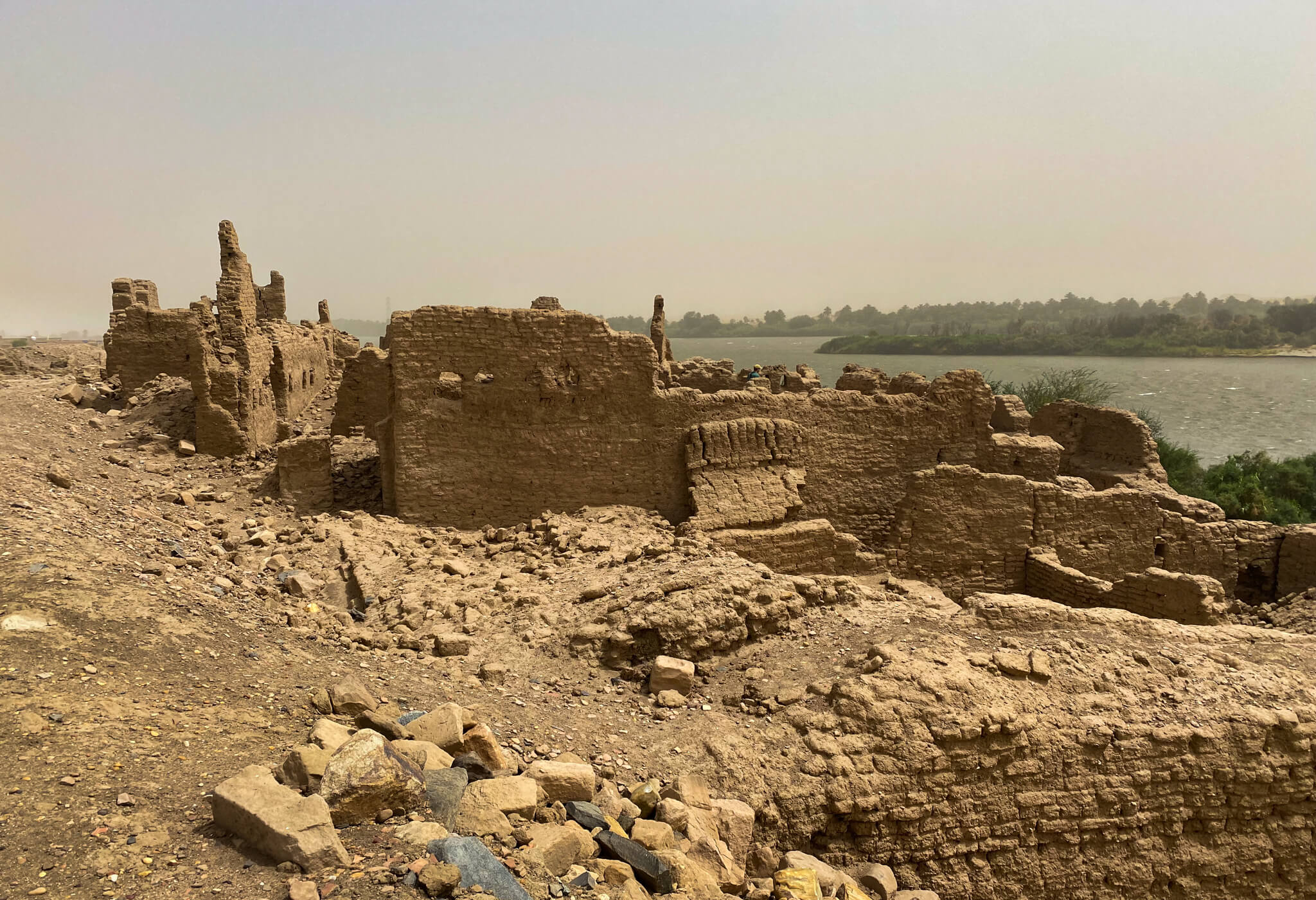
The crumbling remains of the ancient necropolis on Sai Island.
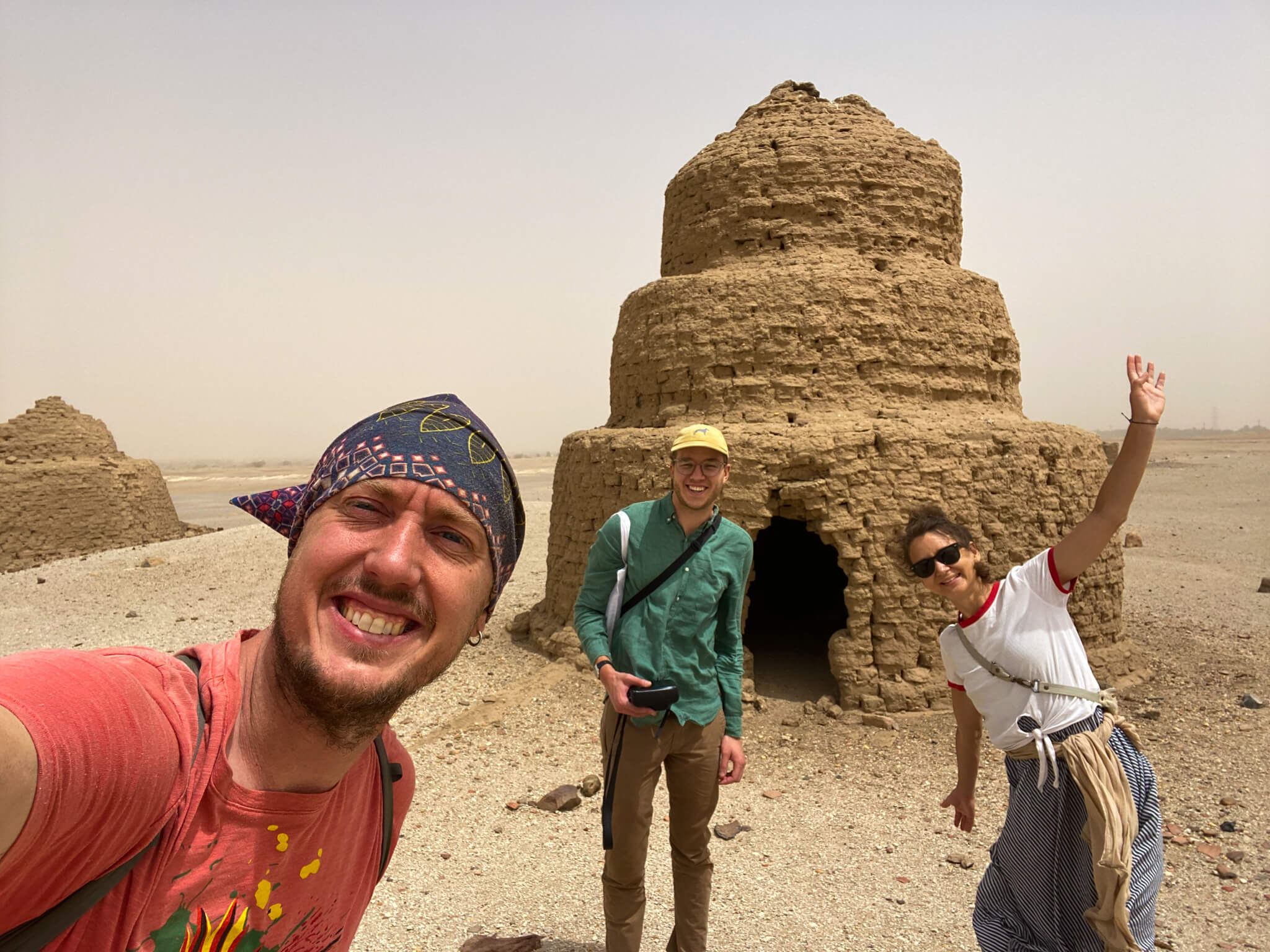
The Meroitic tombs reminded me of huge beehives.

The ferry to Sai Island only operates on market days.
The Meroitic Tomb of Kowikka
Kowikka is a tiny village on the edge of the Nile a bit south of Sai Island. This is one of the lesser known sights and we only found out about it through a poster at the Magzoub Nubian Guest House in Abri. Of all the Meroitic tombs we saw in Sudan, and there were several, this was the largest and most impressive. Magzoub told us that the tomb is still cared for by the family that originally built it around 700 years ago.
The tomb is square and stepped in shape with little windows and a hole in the apex of the roof. A sarcophagus sits in the centre of the floor, covered in a green cloth. It reminded me a bit of the Kaba in Mecca. I asked Magzoub whether the sarcophagus gets wet when it rains and he just laughed. Apparently, it rained a tiny bit in 2021, and the last time they had rain before that was in 1986. Coming from rainy old Scotland, this blew my mind!
Magzoub knows the family that owns the tomb and called ahead for them to unlock it for us. He told us that they expect a tip for doing this, and we each gave them $2 each.
Directions: Kowikka is about 16km south of Abri, just off the highway. As with Sai Island, we went there with Magzoub in his car. However, you could catch a bus or hitchhike from either direction along the highway.

The Meroitic tomb to end all Meroitic tombs at Kowikka!
The Temple of Soleb
The Temple of Soleb is the ruins of a pharaonic temple built by the pharaoh Amenhotep III around 1,350 BC. It was the largest Egyptian temple south of Thebes (near Luxor, in Egypt). However, the remaining ruins are quite small, although they do feature some huge and beautiful stone columns inscribed with hieroglyphics. We were lucky enough to be there at sunrise and it was glorious in the early morning sunlight.
After visiting the temple, we wandered through the nearby farmlands and down to the banks of the Nile, before heading to the village of Soleb, next to the temple. The village is also interesting and features traditional Nubian houses, some with crocodile skulls above the doors.
Directions from Egypt(!): Our route to Soleb was highly unusual. We crossed the border from Egypt at Argeen before realising that the road there is on the western bank of the Nile and most of the places we wanted to visit are on the eastern bank. We could have gone all the way to Dongola, where there’s a bridge across the Nile, but then we would have had to backtrack on the eastern bank for about 230km to Abri.
Looking at Maps.Me, we realised that the highway is only about 1km from the Nile at the Temple of Soleb, and I’d read that there are boats across the river between Soleb and a village called Wawa, on the eatern bank. So we asked the rather surprised bus driver to drop us on the edge of the highway in the middle of the desert and then walked through the sand for a kilometre to the temple.
After visiting the temple, we asked around in the village of Soleb until someone called the local boatman for us, who took us across the river to Wawa. Once on the eastern bank, we were able to catch a bus back north to Abri, avoiding the huge detour we would have had if we’d gone to Dongola.
Directions from within Sudan: The temple of Soleb is located on the western bank of the Nile, about 45km south of Abri. Most people visit from one of the villages, such as Abri or Kerma, on the eastern bank. First, either take one of the minibuses that run up and down the highway or hitchhike to Wawa, the village on the eastern bank opposite Soleb. We took the minibus from Wawa to Abri after visiting and the cost was $3 per person for 45 km. You can use this rate as a guide.
Once you reach Wawa, just ask around in the village for the boatman. In Soleb, not many people spoke English, but we got by by miming a rowing action and people got what we meant. The boat cost us $6 in one direction for two people, bargained down from a starting price of $10.
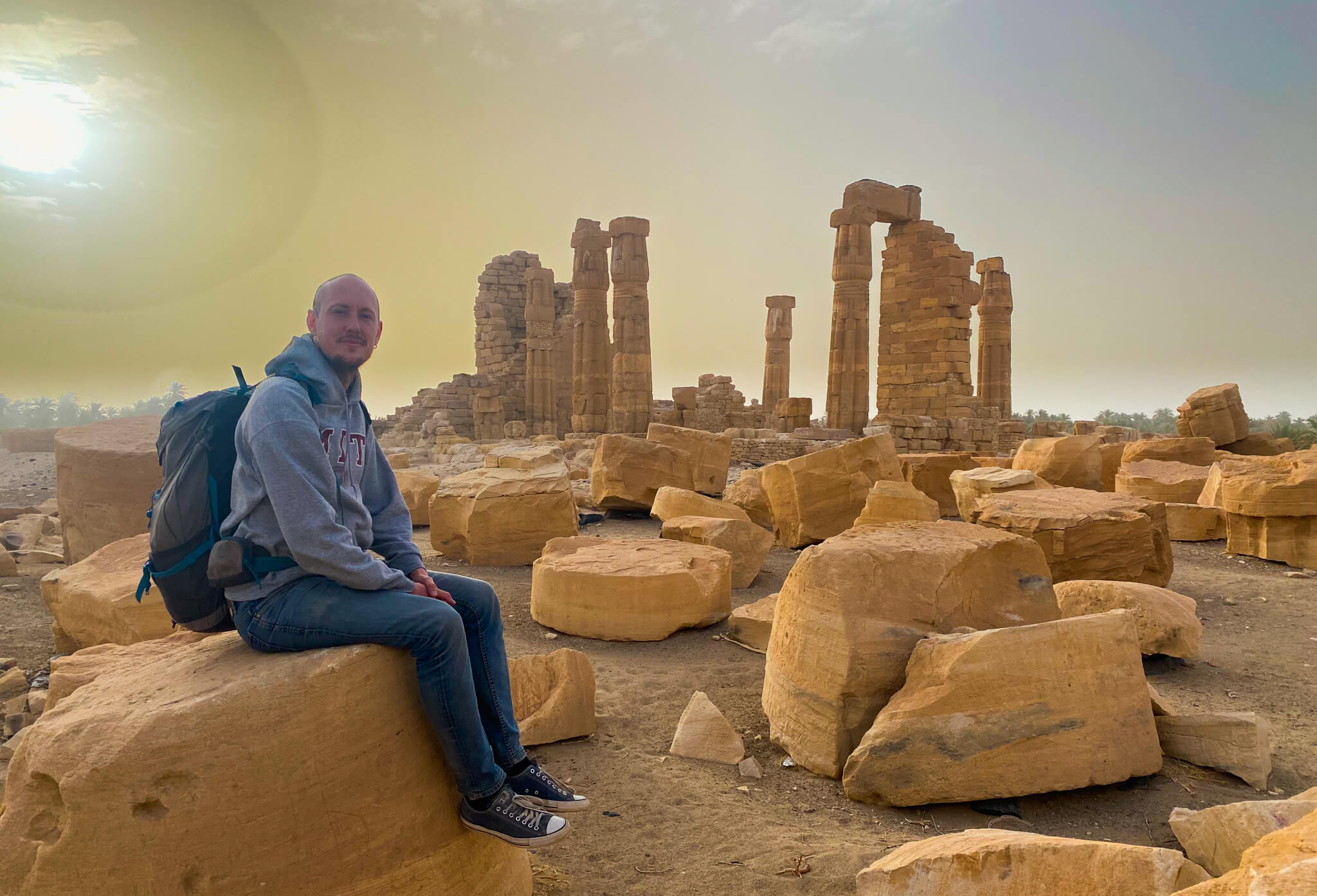
Dawn in one of the best times to visit the Temple of Soleb.
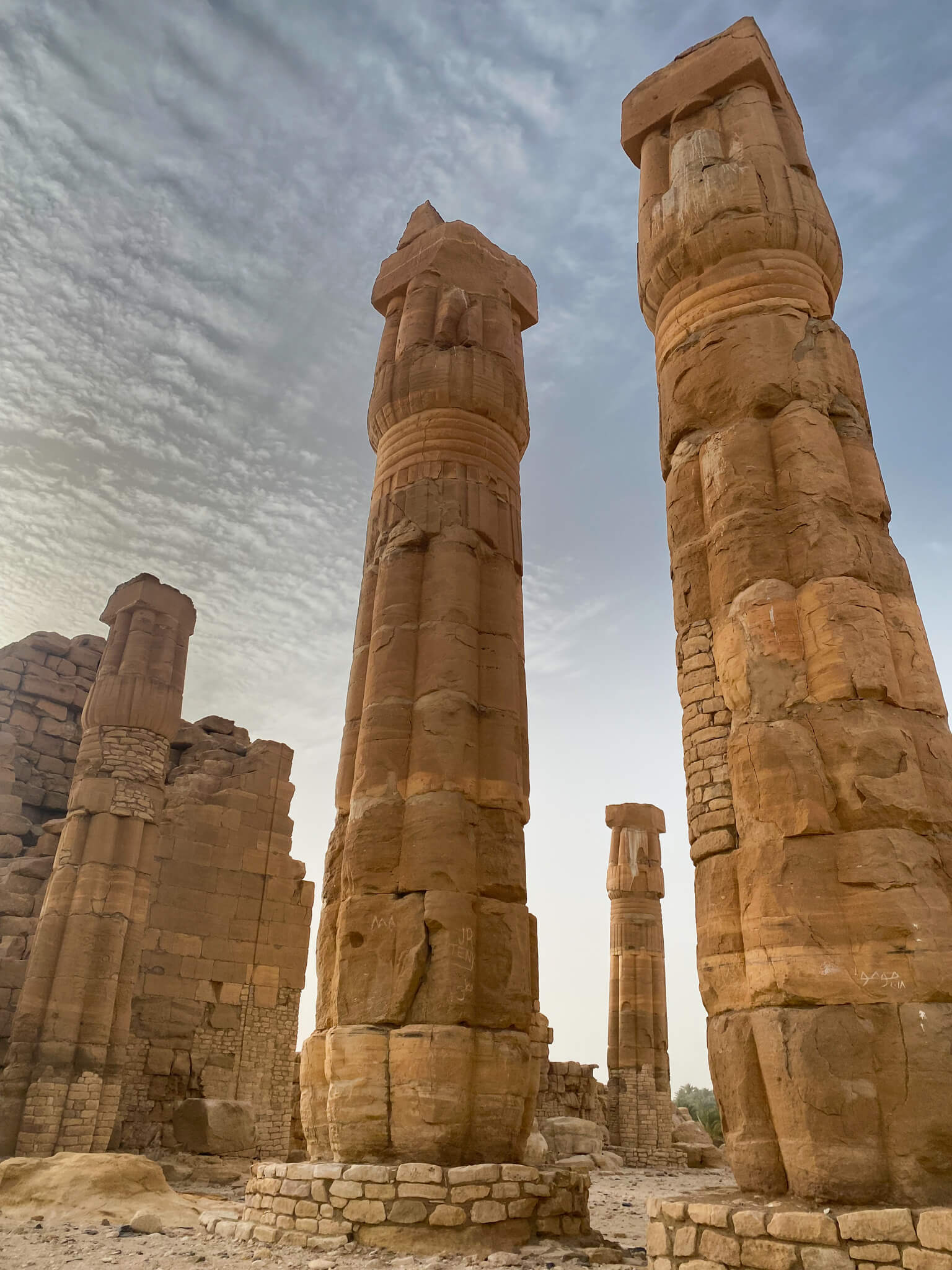
The remaining pillars of the Temple of Soleb are massive.
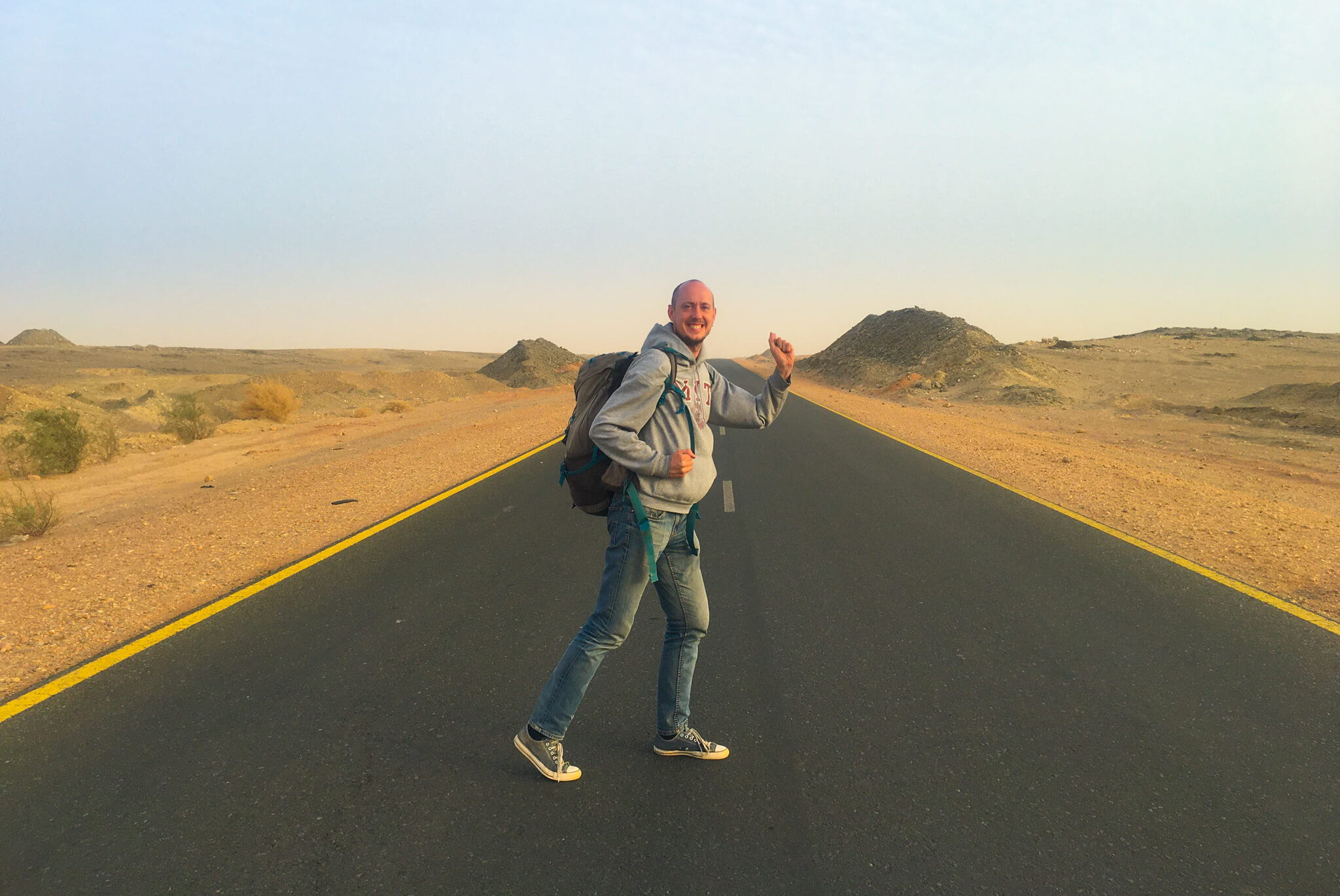
About to start my trek through the Sahara in search of the Temple of Soleb.
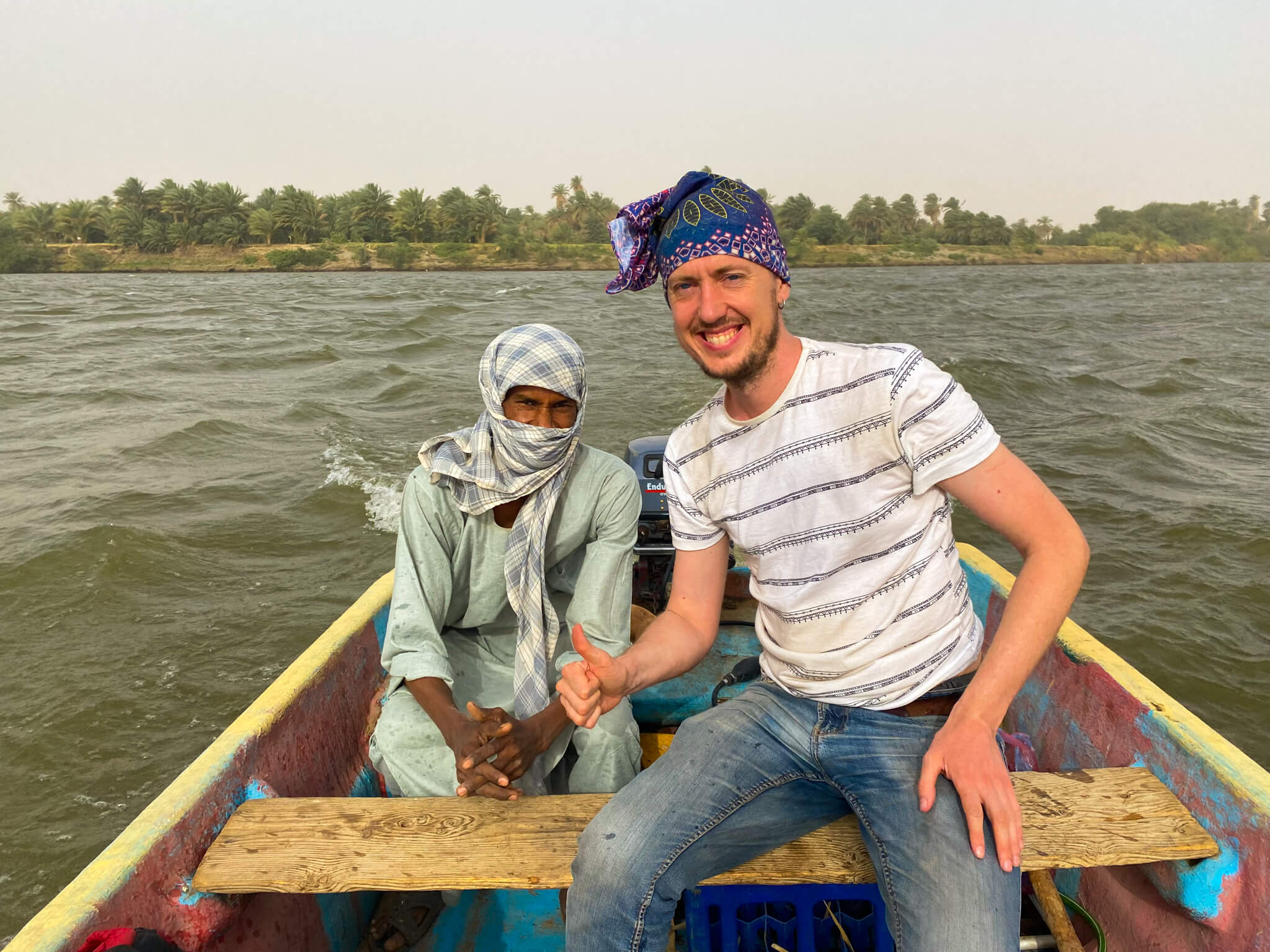
Crossing the Nile from Soleb to Wawa village.
Kerma Nubian Village
The Nubian village of Kerma is home to two major argehologics sites – Douki Gel and the Western Defuffa (see below for details), so it’s a great place to stay for a couple of nights while you check these out. The village itself is really a group of several villages surrounded by farmland and date palms.
Aside from the two main sights, you will also find some Meroitic tombs and other sites scattered throughout the villages. One of the prettiest tombs (see photo at start of article) is not marked on any map, but is located at 19.626058, 30.407230 (here on Google Maps).
During the evening, when it’s not so hot, the village comes alive with tea ladies serving extremely sweet tea and little restaurants by the side of the street. One nice way to spend an evening is to sit in one of the tea houses by the edge of the Nile.

Everyday life is hard work in the Nubian village of Kerma – especially if you’re a donkey.

This mosque is one of the nicest modern(ish) buildings in Kerma.
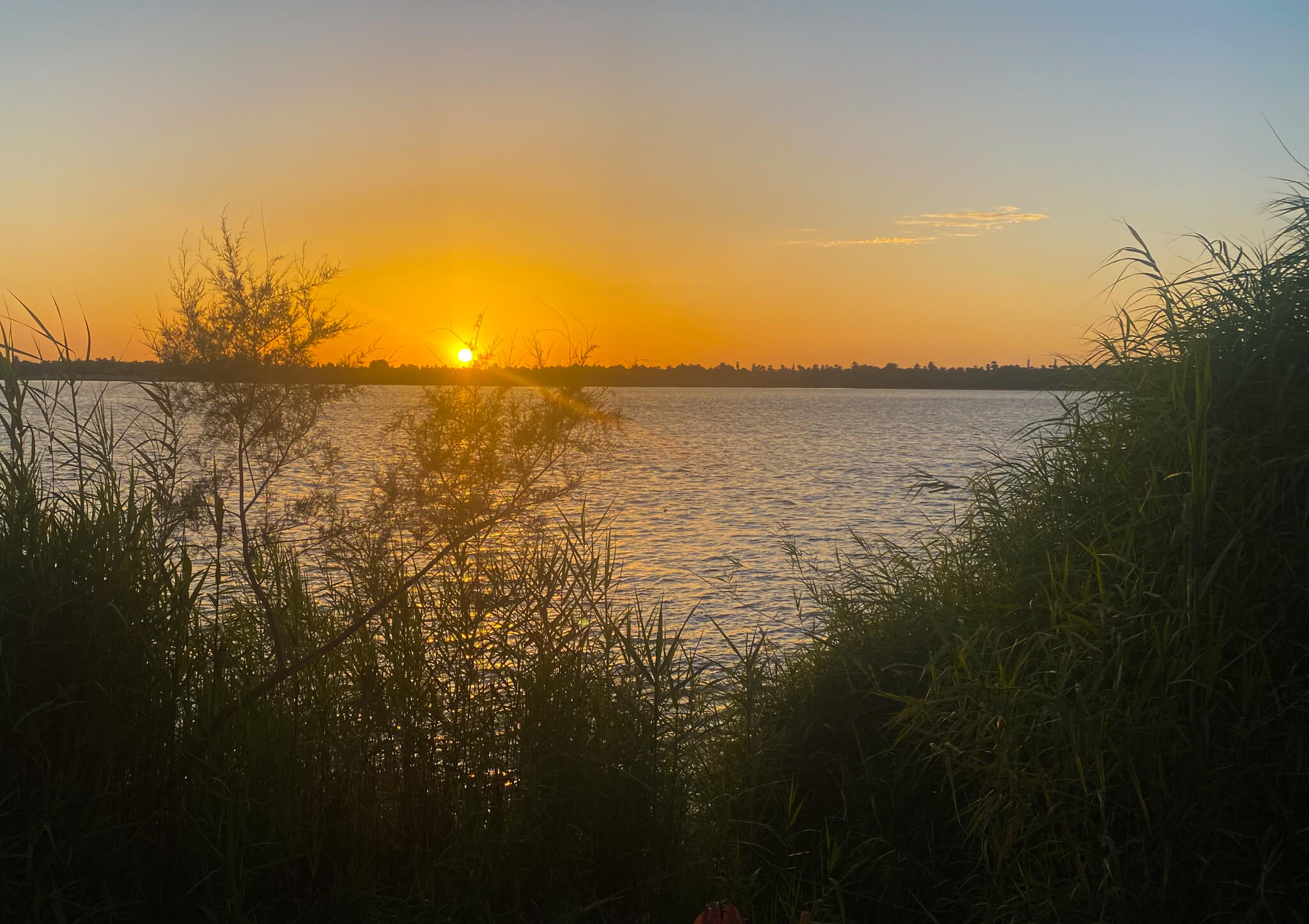
Kerma is the perfect place to watch the sun set over the River Nile.
Doukki Gel
One of Kerma’s key archeological sites, Doukki Gel is the ruins of the ancient city of Kerma, capital of the Nubian kingdom by the same name. The site has only recently been excavated by a joint Swiss, French and Sudanese team. The ancient site encopmasses the ruins of palaces, temples, houses and ancient wells, amongst other structures.
The vastness of the Douki Gel is impressive, although a lot of what is actually visible now is little more than restored foundations of the former buildings. One of the wells is still fairly intact though and beautiful in its brick work. For more information, check out the excavation team’s official Website.
The road into the site from the main village of Kerma village is a tranquil walk through lush farmlands dotted with date palms. We carried a picnic lunch of bread and canned tuna, as it was Ramadan and restaurants were closed. We ate it under the shade of one of the palms, away from the road where we wouldn’t offend any devout local farmers.
Directions: The location is clearly marked on both Google Maps and Maps.Me. The walk from the village of Kerma is about 5km, although you could also find a tuk tuk or taxi to take you if you don’t feel like walking. Another option would be to try to catch a lift with a local taking the same road. People are very friendly here and one farmer offered us a lift on his donkey-drawn cart as we were walking.
LIke most tourist sites in Sudan, the entrance price is supposed to be $20 per person and, unless you’re really into archeology, I don’t think it’s worth the price. We actually entered the site by accident through a gap in the wall (it just so happened that the official entrance was on another road) and no one stopped us when we were exploring the area, so we didn’t pay.
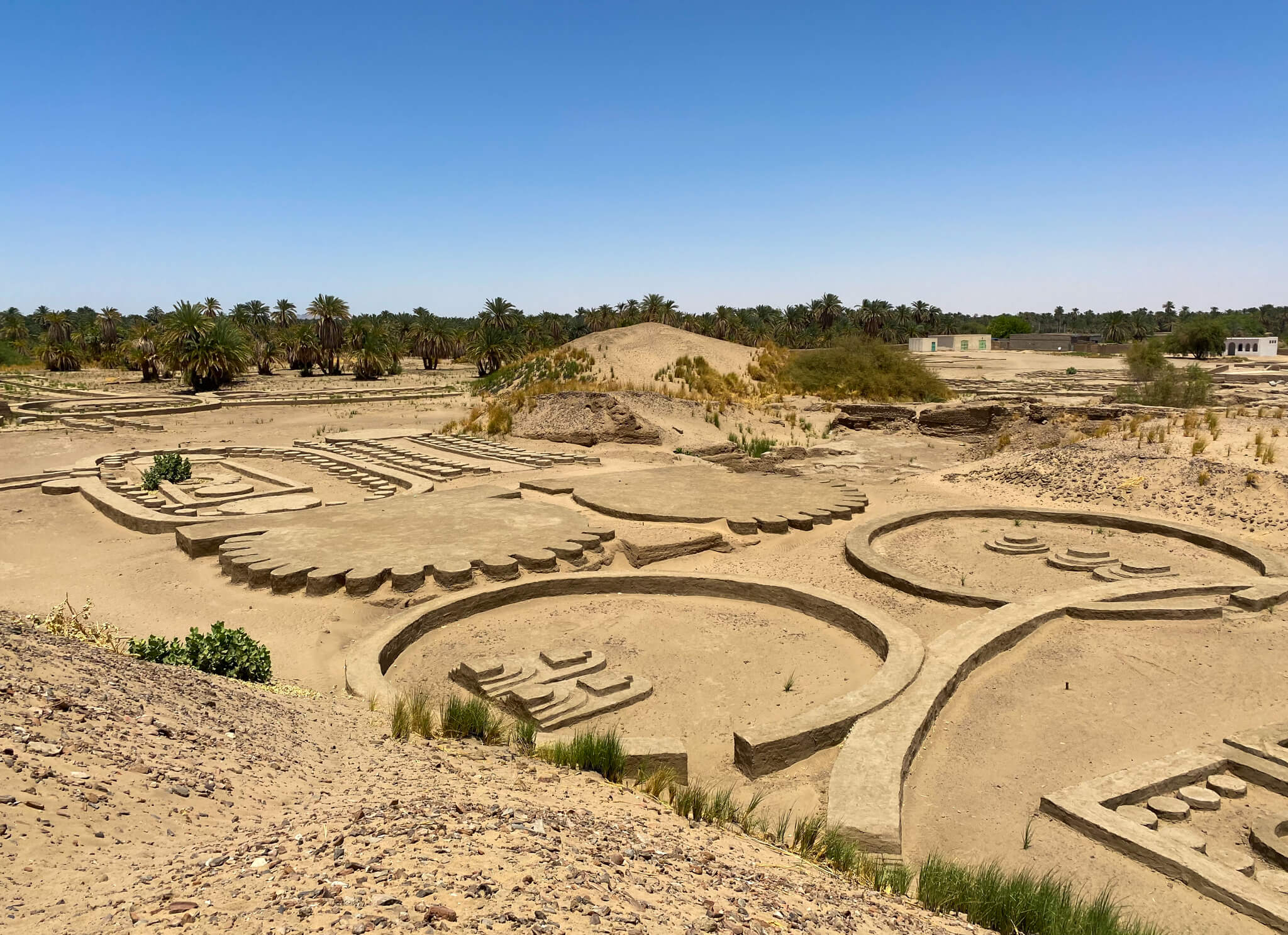
Most of Doukki Gel looks like a vast map of what used to be there.

The well is the most beautiful building remaining in Doukki Gel.
The Western Deffufa
This was my favourite sight in Kerma. It’s a huge temple dating back to the Nubian Kingdom of Kerma. The kingdom stood for around a thousand years, eventually falling to the Egyptians around 1,450 BC. Even today, almost 3,500 years on, the Western Deffufa stands 18m (59 feet) tall and is one of the best-preserved examples of this style of Nubian architecture in the world. You can find more information on the Western Deffufa here.
It’s an amazing feeling to be standing on a structure so ancient and, as very few tourists make it to Kerma, you’ll probably have the whole place to yourself. There is also a museum at the entrance, but that was closed due to Covid when we were there. There are steps up to the top of the deffufa and the view from the top over the nearby villages, the Nile and the millions of date palms is also a sight to see.
Directions: On Google Maps, head to the Kerma Museum, which is also the entrance to the site. The location is also clearly marked on Maps.Me.
The entrance price is again $20. In our case, there were two local cops who asked us to pay. However, they had no tickets and the money was obviously going to go straight into their pockets. I don’t actually have a big problem with this in this case, as it’s still going into the local economy, and this area is dirt poor, but $20 each seemed a bit steep. I had just $13 at the time in my wallet, so I showed them this and told them that was all I had. They took it and let us in.
If you have the time (I didn’t unfortunately), you could also check out the Eastern Defuffa. It’s less famous than the western one, but photos I’ve seen are still impressive. The location is 19.611841, 30.445831 and it’s clearly marked on Maps.Me (here on Google Maps).

The Western Deffufa still stands 18m high after 3,500 years.

The view from the top of the Western Deffufa is quite impressive, as is the feeling of standing on something so ancient.
Other Sights of Nubian Sudan
The northern Nubian region of Sudan contains many more ancient and interesting archaeological sites than I was able to visit. See the images below of a poster in the Magzoub Nubian Guest House in Abri for basic guidance. If you need help finding any of these, Magzoub would definitely know how to get to them.
- The sights of Nubian Sudan from a poster in the Magzoub Nubian Guest House in Abri (page 1).
- The sights of Nubian Sudan from a poster in the Magzoub Nubian Guest House in Abri (page 2).
Where to Eat in Abri and Kerma
I was travelling during Ramadan, so most restaurants were closed during the day. In Abri, Magzoub took us to his family’s house and we ate delicious home-cooked meals.
In Kerma, finding food during Ramadan was really challenging. Even in the evening, most places were closed. We did find one local place on the edge of the street serving foul (a popular dish made from fava beans, pronoucned like “fool” in English). It’s not marked on Google Maps, but the location is 19.638813, 30.407703. The price was around $4 per person.

Eating foul (fava beans with a tasty sauce) at a roadside eatery in Kerma. This was the only food we could find in the evening during Ramadan.
Where to Stay in Abri and Kerma
Abri: The best place to stay is the Magzoub Nubain Guest House. Magzoub, the owner, is always cheerful, full of knowledge about the region and obviously enjoys hanging out with his guests. As many travellers in this region start from Abri (or just above in Wadi Halfa), talking with him is a great opportunity to answer any questions you may have before travelling on.
The guest house is in the traditional Nubian style with a huge crocodile skull displayed over the entrance. The rooms are basic, but have wifi (which was very rare in Sudan generally). Me and my companions paid $25 for a single room and $30 for two people sharing. The price included dinner and breakfast and, as it was Ramadan and restaurants were closed, Magzoub even threw in lunch as well.
If you’re on a really tight budget, there is another place that offers basic accomodation in a shared dorm for just a few dollars. The location is 20.805763, 30.347303 (here on Google Maps).

Saying goodbye to Magzoub in front of his guest house in Abri. Notice the huge crocodile skull over the main entrance!
Kerma: We stayed at the Nile Hotel, which was very cheap, at $7.50 a night for two people sharing. Unfortunately, I can’t recommend it, as when I got up in the morning I was covered in little red bumps – it had bed bugs. There are other hotels marked on Maps.Me so either try them or ask around in the village.
Wawa: There is a local farmer in Wawa who speaks great English and rents out 3 or 4 rooms in his house, at the southern end of the village. The location is marked on Maps.Me as simply ‘Hotel’ and the coordinates are 20.446707, 30.346699 (here on Google Maps). The price is $6.
If you want to stay in any of the other villages in the region, just ask around. You’ll probably find some friendly local who’s happy to host you.
Where to Change Money in Abri and Kerma
Sudan was cut off from the international banking network for many years, due to US sanctions. Even now, ATMs do not accept foreign bank cards, so it’s important to bring plenty of foreign currency (preferably USD). Banks usually give the best exchange rates when changing to Sudanese pounds.
Abri: There is a Bank of Khartoum that exchanges money near the Magzoub Nubian Guest House. The location is not marked on Maps.Me or Google Maps, but is at 20.804591, 30.347994 (here on Google Maps).
Kerma: The Sudanese Islamic Bank next to the Nile Hotel can change money. The location is at 19.642973, 30.406164 (here on Google Maps).
If you find yourself with no Sudanese pounds when the banks are closed, ask around. In Kerma, the banks were shut all weekend (not necessarily the case in other cities), but a friendly guy at our guest house knew a local guy who could change money for us at a slightly worse rate (we lost about $4 when exchanging $100 compared to the rate at the banks).
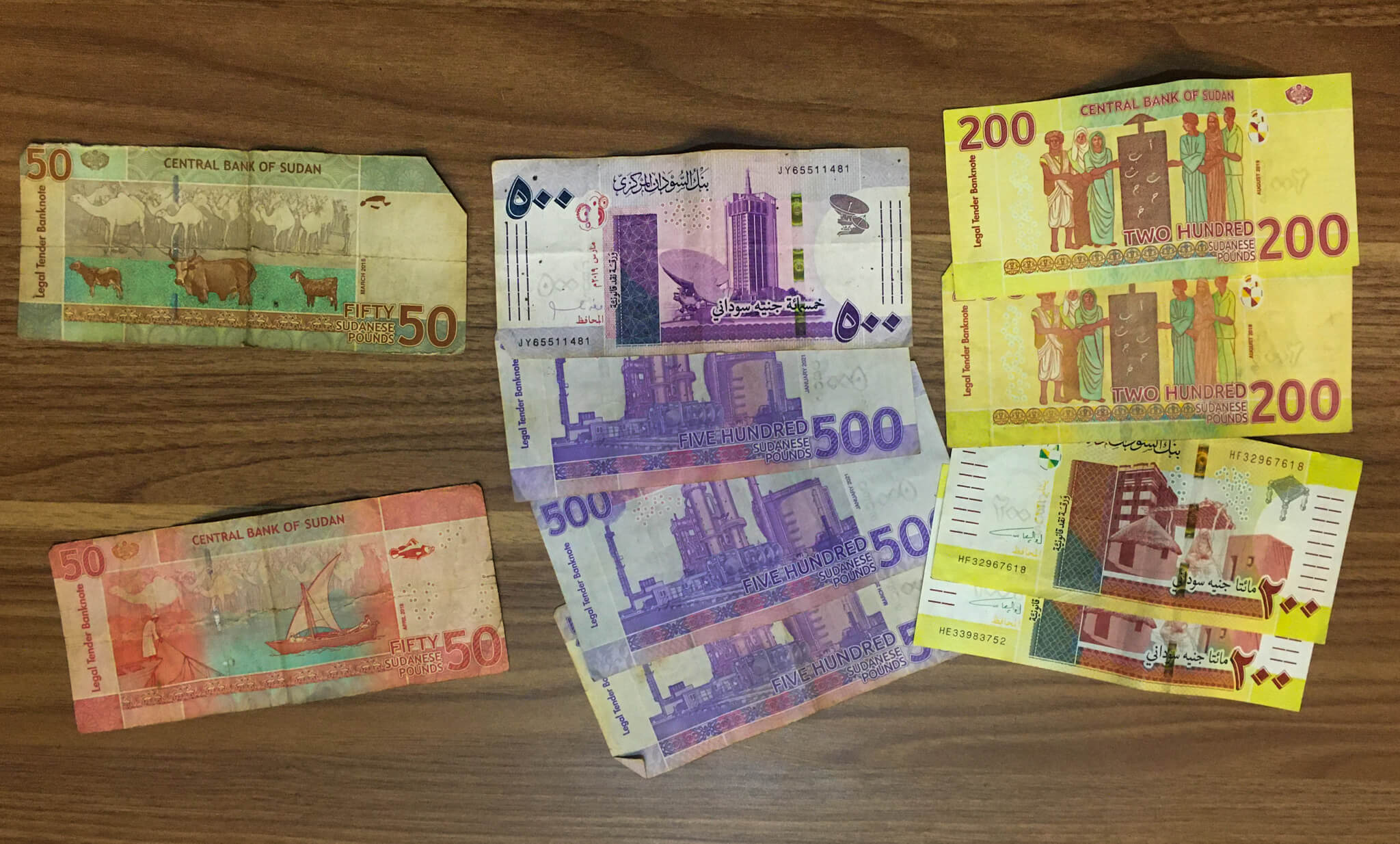
The Sudanese pound was at 550 to the USD when I was there, up from 55 at the beginning of 2021.
Getting Around Abri, Kerma and Neighbouring Villages
Walking around the villages in this region is a pleasure, but getting between them can be a hassle. There is not much transport infrastructure in the far north of Sudan. Generally, the further south you go, the easier it is, as there are more minibuses and just more vehicles on the road in general, so it’s also much easier to hitchhike.
Your main transport options are as follows:
Minibuses: Local minibuses work very well when the timings work out (there are no schedules, they just depart when full). During our trip from Kowikka, 16km south of Abri, to Kerma, the only minibuses that passed were already full. Maybe they’d filled up in Abri. As a result, our only option was to hitchhike.
From Kerma heading south towards Dongola, the situation was very different. Minibuses from Kerma to Dongola leave frequently from Bergeig, one of the villages in the Kerma area. The price is $3 per seat. If, like us, you stay in the actual village of Kerma, minibuses to Bergeig leave frequently from in front of the Nile Hotel (located at 19.643240, 30.406091, here on Google Maps) and cost $0.60 per person.
Hitchhiking: People in Sudan are generally very friendly and hitchhiking was relatively easy. The exception was between Kowikka and Kerma. People were still extremely friendly, but there were just so few cars on the road, it was hard to find a lift. Also, many vehicles were only going a short distance. As a result, the 155km journey from Kowikka to Kerma took us around 7 hours and involved frequent changes of vehicle. It would probably be easier outside of Ramadan.
The trick really is to persevere – you will find a lift eventually. And if you get stuck somewhere for a night, that will probably be an amazing experience too.

Five minutes after we hitched a ride on this pickup, a tyre exploded, and we we ended up stuck on the edge of the road of the next 3 hours while the guys found someone to fix it. This is what travel stories are made of!

Truck are slow, but the drivers (Sudanese and Egyptian) were all very friendly and happy to pick us up.

This Egyptian truck driver was so friendly that he even invited us to join him for iftar (meal to break the fast at sunset during Ramadan). He had a whole mini kitchen in his the side of his truck!
Getting to Abri and Kerma
To get to Abri and Kerma, you will either be travelling from Dongola heading north or from Wadi Halfa heading south. As already mentioned there are plenty of minibuses and hitchhiking is always an option.
From Dongola, minibuses depart from a shiny new bus station on the outskirts of the city. The location is not on any mapping tool, but is at 19.196511, 30.435104 (here on Google Maps). The price is $10 to Abri and $3 to Kerma.
There were actually passenger trains from Khartoum until a few years ago, but sadly these have now been discontinued, with only freight trains still operating.
Safety in Abri and Kerma
This has to be one of the safest areas of Sudan. People were incredibly friendly and helpful. The only issue we did have was two youngish guys pestering us to take photos with Anna while hitchhiking. They were a bit creepy, but not aggressive and eventually left us alone.
Visiting Abi and Kerma During Ramadan
There are pros and cons to visiting during Ramadan. On the plus side, all the tourist sites were open, but most of the ticket collectors weren’t there, so many sites were free by default.
On the negative side, finding food was often challenging, especially at lunch time. We did always manage to find a bakery, so we often bought bread and canned tuna or local cheese to eat for lunch. Note that a bakery here means a place that bakes one type of bread, so there wasn’t much variety. Eventually, we figured out that there was often food around bus stations, as local people are allowed not to fast if they are travelling (apparently it must be more than 80km).

Nubians often decorate their front gates with crocodile skills, such as this one in Soleb village.
More About Sudan
Sudan is a beautiful and unique country, but not the easiest place to travel. Check out my other Sudan guides for everything you need to know to backpack independently around this crazy country:
How to Visit Kassala and Hike the Taka Mountains
Kassala and the Taka Mountains This travel blog contains everything you need to know to visit Kassala independently and all the best things to see and do there. It includes how to travel to Kassala with public transport, where to stay, what to eat and how to stay...
What to do in Port Sudan and the Coral City of Suakin
Sudan's Red Sea Coast: Port Sudan and Suakin This travel blog contains everything you need to know to visit Port Sudan and the coral city of Suakin independently and all the best things to do there. It includes the best sights, how to travel there with public...



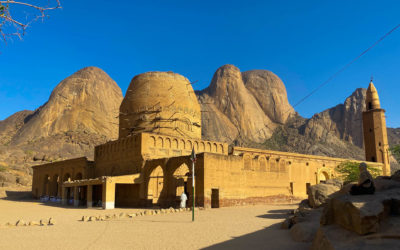
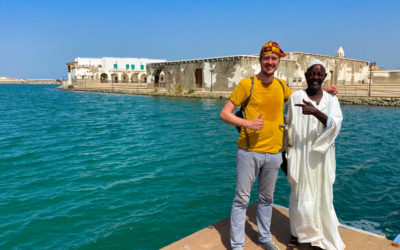
Your account on Abri and Nubia is great ! I am Sudanese but your narrative has been very helpful to me when I visited the area. What you wrote is informative and accurate. Thank you!
Thank you so much for your kind comments and great to hear that the article is helpful not just for foreign travellers, but for locals too!